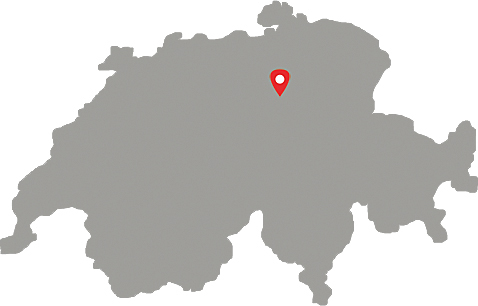If you leaf through faded, sepia photographs of the Lake of Zurich taken in the 1880s, the picture is of an almost uninterrupted swathe of vineyards all around the lake on both north and south shores. Meilen, on the lake’s north side, was by far its most viniferous village. The same picture today shows wall-to-wall real estate. This is Zurich’s famed Gold Coast, home to some of Switzerland’s most eye-wateringly expensive property.
Yet from the wine-red carriages of the Gold Coast Express train that skirts the lake, you can still catch glimpses of rows of vines, neatly squeezed into every available unbuilt space. Some of these vines belong to the Schwarzenbach family, whose home and winery are on Meilen’s Seestrasse. When the winery was founded in 1912 by Hermann Schwarzenbach, it was the typical mixed farm with vines, fruit trees, rhubarb – and a few cows. Today, they farm nine hectares of vineyards in and around the village.
Successive sons have all been christened Hermann. Even Alain Schwarzenbach, who with his partner Marilen took over from his parents in 2016, has Hermann as a second name. Recognisable by a shock of Scandi-blonde hair just like his mother Cécile, he studied oenology across the lake in Wädenswil and worked in both Australian and New Zealand vineyards. Marilen’s background is in wine marketing; she too has gained valuable experience abroad, working in the Italian South Tyrol and in Tasmania.
Parents Hermann and Cécile now work fifty percent in the winery, which leaves valuable time to spend “high-fiving” with the newest grandchild. They continue to devote their considerable energy and charm to promoting not just Schwarzenbach wine (particularly the typical Zurich grape Räuschling, in whose revival they have played a key role) but also those of the Zurich region and of Switzerland in general. You’ll meet them at events put on by the Mémoire des Vins Suisses, of which Cécile is treasurer.
The family has always been distinguished by its solidarity with fellow winemakers and encouragement of the younger, upcoming generation – the recent transfer of powers to Alain and Marilen is a good example. Every year they also take two apprentices, who live and work at the winery in between their studies. It’s a tough ask for any small business to invest time and money in apprenticeships but the family considers it important to train the next generation of winegrowers.
A further striking example is the way they share space in their brand-new cellars with neighbouring winemakers who lack their own winemaking facility. It’s a win-win situation, explains Alain. It saves the colleagues the expense of building or renting their own cellar, which would be prohibitive here on the Gold Coast, and it allows them to pool experiences, taste one another’s wines and bounce off each other with new ideas and initiatives.
Räuschling, the ancient variety so intimately linked to the region that it is still sometimes known in dialect as Zürirebe or “Zurich grape”, is hugely important to the Schwarzenbachs. Fully one-third of their vineyards are planted with it and it’s largely thanks to them that this variety is enjoying a bit of a revival. Mostly it gives a crisp, light (seldom over 12 percent), lemony wine, the perfect accompaniment to the lake fish that are still pulled out of the water just across the street from the winery. They make three examples: an uncomplicated, thirstquenching entry-level wine, a later-harvested Auslese with a touch of residual sweetness to balance the grape’s naturally high acidity, and the gorgeous Räuschling Seehalden (their Mémoire des Vins Suisses wine), named after the vineyard perched precariously above the railway line with its feet almost in the lake.
A fourth Räuschling, which underlines the Schwarzenbach collegial spirit, is named R3. The idea behind this three-handed cuvée, created by Alain’s father and neighbouring winemakers Rico Lüthi in Männedorf and Monica Hasler in Stäfa, is to produce a distinctive wine that represents faithfully the typical characteristics of the grape and demonstrates its full potential. Each winemaker selects their best grapes from three distinct terroirs, vinifies them separately using a specific Räuschling yeast and then brings them together in a blend agreed upon by all three players.
Räuschling is so centre-stage at Schwarzenbach that it’s easy to lose sight of the 20 other grape varieties they work with. Join the many private customers in their quaint, old-fashioned tasting room on the Seestrasse (half of all their wines are sold directly from the winery) and make sure that amongst the wines sampled, you include their quaffable Riesling-Sylvaner, the lively Federweisser rosé from the free-run juice of their Pinot Noir which has a slight prickle of CO2, and the deftly oaked, elegant Chardonnay. As often happens, I prefer their entry-level, fruit-filled Pinot Noir to the oaked one or even the Selection, and have a soft spot for Passionata, a blend, which has all the curves of Merlot plus a bit of punch from 10 percent Cabernet Sauvignon, and which won itself a medal in the Decanter World Wine Awards.

|
ADDRESS: Seestrasse 867 CH-8706 Meilen CONTACT: Tel. 044 923 01 25 |
WINES TO LOOK OUT FOR: Räuschling Pinot Noir Chardonnay Passionata |
|
wein@reblaube.ch |
|
|
Price range 14 to 34 SFr. |
|
|
HIGHLIGHTS: Visits welcomed Saturdays 10.30–4 or weekdays by appointment when wines can be tasted and purchased. Wines can also be ordered from the website. |
|